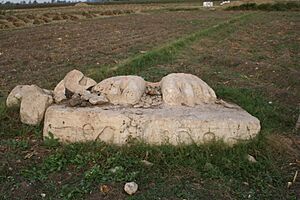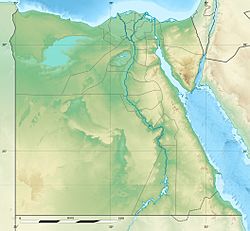Pi-Ramesses facts for kids

The feet of a Ramses II statue at Pi-Ramesses
|
|
| Location | Qantir, Al Sharqia Governorate, Egypt |
|---|---|
| Region | Lower Egypt |
| Coordinates | 30°47′56″N 31°50′9″E / 30.79889°N 31.83583°E |
| Type | Settlement |
| Area | 18 km2 (6.9 sq mi) |
| History | |
| Builder | Ramesses II |
| Founded | 13th century BCE |
| Abandoned | Approximately 1060 BCE |
| Periods | New Kingdom to Third Intermediate Period |
Pi-Ramesses was an important ancient city in Egypt. It was the new capital city built by the powerful Pharaoh Ramesses II. He ruled Egypt from about 1279 to 1213 BCE. Pi-Ramesses was located at a place called Qantir, close to an older city named Avaris.
Before it became a capital, Pi-Ramesses was a summer palace for Pharaoh Seti I, Ramesses II's father. Some historians think it might have been started even earlier by Ramesses I, the grandfather, when he worked for Pharaoh Horemheb. The name Pi-Ramesses means "House of Ramesses" in ancient Egyptian.
Contents
Finding the Lost City
For a long time, people weren't sure exactly where Pi-Ramesses was. In 1884, a famous archaeologist named Flinders Petrie started digging in Egypt. He began his work at a place called Tanis. Later, in the 1930s, another archaeologist, Pierre Montet, also explored the ruins at Tanis.
They found many broken stone pieces from the time of Ramesses II at Tanis. Because of this, archaeologists first thought that Tanis was the lost city of Pi-Ramesses. However, they later realized that these monuments were not originally built there. They had been moved from somewhere else.
Modern Discoveries
In the 1960s, an archaeologist named Manfred Bietak made a big breakthrough. He knew that Pi-Ramesses was built on the easternmost branch of the Nile River at that time. He carefully mapped the old branches of the Nile Delta. He found that the Pelusiac branch was the easternmost during Ramesses' rule. The Tanitic branch, where Tanis was located, didn't even exist then.
So, excavations began at places with the most pottery from Ramesses' time: Tell el-Dab'a and Qantir. Even though there were no signs of old buildings on the surface, they soon discovered that Tell el-Dab'a was actually Avaris, the capital of the Hyksos. Qantir was then identified as the true site of Pi-Ramesses. Qantir is about 30 kilometers (19 miles) south of Tanis. Tell el-Dab'a (Avaris) is about 2 kilometers (1.2 miles) south of Qantir.
In 2017, archaeologists found children's footprints in a mortar area. They also found pieces of painted walls, possibly from a palace or temple. These discoveries help us learn more about what life was like in this ancient city.
Life in Pi-Ramesses
Ramesses II grew up in this area, which might be why he chose to build his capital here. But there were also important political reasons. Pi-Ramesses was much closer to Egypt's allies in Asia and to the border with the powerful Hittite empire, who were sometimes enemies.
This location meant that important news and messages from diplomats could reach the pharaoh much faster. Also, the main part of the Egyptian army was based in the city. This allowed them to quickly respond to attacks from the Hittites or other groups.
City Layout and Features
Pi-Ramesses was built right on the banks of the Pelusiac branch of the Nile. It was one of the largest cities in ancient Egypt, with over 300,000 people living there. The city was very grand, and poets wrote about its beauty.
The city covered about 18 square kilometers (7 square miles). It was about 6 kilometers (3.7 miles) long and 3 kilometers (1.9 miles) wide. Using special radar, archaeologists have mapped its layout. It had a huge central temple and a large area of fancy houses along the river. These houses were built in a neat grid pattern of streets. There was also an area with many smaller houses and workshops.
Archaeologists believe Ramesses' palace is under the modern village of Qantir. The Austrian team led by Manfred Bietak found many canals and lakes. They described Pi-Ramesses as the "Venice of Egypt" because of all the waterways.
A surprising discovery was made in the city's stables. There were small water tanks next to each of the 460 horse stalls. Researchers found that horses could use these tanks as toilets, which helped keep the stable floors clean and dry.
Why the City Was Abandoned
Pi-Ramesses thrived for over a century after Ramesses II died. However, around 1060 BCE, the Pelusiac branch of the Nile River began to fill with silt and mud. This meant the city no longer had a good water supply. The river eventually changed its course, moving west to a new branch called the Tanitic branch.
Because of this natural change, the pharaohs of the Twenty-first Dynasty of Egypt decided to move the capital. They built a new city called Djanet (also known as Tanis) on the banks of the new river branch. Tanis was about 100 kilometers (62 miles) northwest of Pi-Ramesses.
The pharaohs moved many of the old temples, statues, and monuments from Pi-Ramesses to the new capital. Huge obelisks and statues, some weighing over 200 tons, were moved in one piece. Larger buildings were taken apart and rebuilt at Tanis. Stone from less important buildings was reused to construct new temples and structures in the new capital.
Pi-Ramesses in the Bible
The ancient city of Pi-Ramesses is thought to be the same city mentioned in the Bible. The Book of Genesis says that the Hebrew people lived in the "land of Rameses." The Book of Exodus mentions "Raamses" as one of the cities where the Israelites were forced to work. It also says they started their journey from this city.
Because of this, many modern archaeologists believe the biblical Raamses is the same as Pi-Ramesses, the city of Ramesses II. Ramesses II moved Egypt's capital to Pi-Ramesses partly because it was a good military location. He built storehouses, docks, and military buildings there. This might be why the Bible calls it a "treasure city."
See also
- List of ancient Egyptian towns and cities
- List of historical capitals of Egypt



